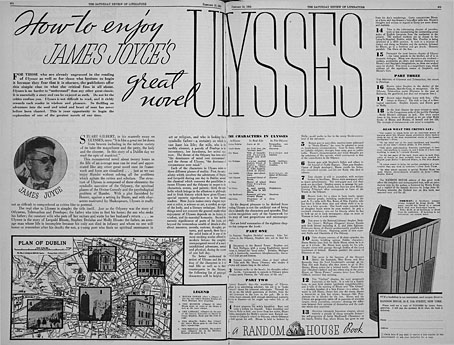Random House offering readers a guide to the labyrinth in 1934.
I’ve not done a Bloomsday post for the past couple of years so here you go. Via Jorge Luis Borges: Selected Non-Fictions (1999), edited by Eliot Weinberger.
A total reality teems vociferously in the pages of Ulysses, and not the mediocre reality of those who notice in the world only the abstract operations of the mind and its ambitious fear of not being able to overcome death, nor that other reality that enters only our senses, juxtaposing our flesh and the streets, the moon and the well. The duality of existence dwells within this book, an ontological anxiety that is amazed not merely at being, but at being in this particular world where there are entranceways and words and playing cards and electric writing upon the translucence of the night. In no other book (except perhaps those written by Gómez de la Serna) do we witness the actual presence of things with such convincing firmness. All things are latent, and the diction of any voice is capable of making them emerge and of leading the reader down their avenue. De Quincey recounts that it was enough to name the Roman consul in his dreams to set off fiery visions of flying banners and military splendor. In the fifteenth chapter of his work, Joyce sketches a delirious brothel scene, and the chance conjuring of any loose phrase or idea ushers in hundreds—the sum is not an exaggeration but exact—of absurd speakers and impossible events.
(1925; translated by Suzanne Jill Levene.)
Plenitude and indigence coexist in Joyce. Lacking the capacity to construct (which his gods did not bestow on him, and which he was forced to make up for with arduous symmetries and labyrinths), he enjoyed a gift for words, a felicitous verbal omnipotence that can without exaggeration or imprecision be likened to Hamlet or the Urn Burial…Ulysses (as everyone knows) is the story of a single day, within the perimeter of a single city. In this voluntary limitation, it is legitimate to perceive something more than an Aristotelian elegance: it can legitimately be inferred that for Joyce every day was in some secret way the irreparable Day of Judgment; every place, Hell or Purgatory.
(1941; translated by Esther Allen.)
Previously on { feuilleton }
• A Portrait of the Author
• The Labyrinth
• The Duc de Joyeux
• Dubliners
• Covering Joyce
• James Joyce in Reverbstorm
• Joyce in Time
• Happy Bloomsday
• Passages from James Joyce’s Finnegans Wake
• Books for Bloomsday


